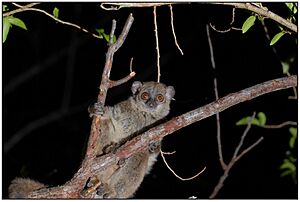Northern sportive lemur facts for kids
Quick facts for kids Northern sportive lemur |
|
|---|---|
 |
|
| Conservation status | |
| Scientific classification | |
 |
|
| Distribution of L. septentrionalis | |
| Synonyms | |
|
The northern sportive lemur (Lepilemur septentrionalis) is a type of lemur found only in Madagascar. It is also known as the Sahafary sportive lemur or northern weasel lemur. This lemur is in great danger because its home is shrinking and humans are causing problems. Scientists have listed it as Critically Endangered, meaning it could soon disappear forever.
Contents
About the Northern Sportive Lemur
The northern sportive lemur is named for the "sporty" boxing-like pose it takes when it feels threatened. It is one of the smallest lemurs in its group. These lemurs grow to be about 53 centimeters (21 inches) long. Their head and body are about 25 cm (10 in), and their tail is about 28 cm (11 in). They usually weigh between 0.7 to 0.8 kilograms (1.5 to 1.8 pounds).
Their fur is grey-brown, with a darker grey stripe down their back. Their belly is grey. Their ears are smaller compared to other lemur species. These lemurs often sit upright, holding tightly to tree branches with their special padded hands and feet. They can jump easily from this position, making them very good at living in trees. Their large, forward-facing eyes help them see well, especially in the dark.
Where They Live and Their Home
The northern sportive lemur lives in a very small area in northern Madagascar. You can find them from the Loky River to the coast. Their natural home is in small areas of deciduous forests. These forests are near villages like Madirobe and Ankarongana in the Sahafary region. They also live near a small mountain called Andrahona.
How They Behave and Live
Northern sportive lemurs are nocturnal, which means they are active at night. They search for food when it's dark and sleep during the day. They usually sleep in holes in trees or hidden among thick leaves. They pick sleeping spots that are about 1 to 8 meters (3 to 26 feet) high.
Female lemurs will leave their babies on a branch while they go to find food. Male lemurs usually live alone and protect their own areas. A male's territory might overlap with the areas where several females live. During mating season, males will fiercely defend their territory from other males.
These lemurs communicate in a few ways. They use scent marks, like leaving their droppings in special spots, to mark their territory. They also use different calls. One call sounds like a loud crow and tells other lemurs where they are. Another call is a "contact rejection call," which is a series of hisses. This call is often heard when two lemurs get too close to each other.
Life Cycle and Reproduction
Northern sportive lemurs usually have one baby per year. The breeding season is from April to August. A baby lemur stays in its mother's womb for about 120 to 150 days. The babies drink milk for about 4 months. They become independent and can live on their own after about 1 year.
What They Eat
The northern sportive lemur mainly eats leaves, which makes them foliovorous. But they also eat fruits and flowers to get more nutrients. Like other sportive lemurs, they have a special way of digesting their food. They eat their own poop, a process called caecotrophy. This helps them digest their food a second time to get all the nutrients. They have a large part of their gut called a cecum, which is full of bacteria. These bacteria help them break down tough plant material like cellulose into sugars and starches.
Conservation and Threats
The northern sportive lemur faces many dangers. Some animals hunt them, like the native Malagasy tree boa, which catches them while they are sleeping. Large birds of prey, like eagles and owls, also hunt these lemurs.
Humans are also a big threat. People cut down the forests where these lemurs live to make charcoal. This destroys the lemurs' homes and makes their living area smaller and smaller. Northern sportive lemurs are also hunted illegally for their meat.
Because of all these threats, there are only a few hundred northern sportive lemurs left. This is why they are listed as Critically Endangered. They are also protected by CITES Appendix I, which means trading them is only allowed in very special cases. Sadly, the areas where these lemurs live are not officially protected. Even the Andrahona Forest, which is considered a sacred place, shows signs of human activity.


